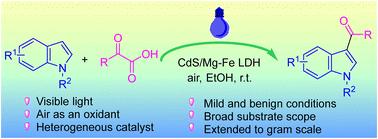CdS/ Mg-Fe层状双氢氧化物:用于吲哚与α-酮酸酰化的多功能异相光催化剂
IF 9.2
1区 化学
Q1 CHEMISTRY, MULTIDISCIPLINARY
引用次数: 0
摘要
利用两种材料的互补性,将CdS和Mg-Fe LDH偶联,成功构建了CdS/ Mg-Fe层状双氢氧化物(LDH)。这种稳定、可回收的非均相光催化剂可实现吲哚与α-酮酸的c3酰化反应。该反应是在室温蓝光照射下进行的,使用大量廉价的空气作为氧化剂。该方法易于获得3-酰基吲哚,收率高。cd / Mg-Fe LDH可以多次回收再利用,而不会明显失去光催化活性。本文章由计算机程序翻译,如有差异,请以英文原文为准。

CdS/Mg–Fe layered double hydroxide: a versatile heterogeneous photocatalyst for the acylation of indoles with α-keto acids†
The CdS/Mg–Fe layered double hydroxide (LDH) was successfully constructed by coupling CdS and Mg–Fe LDH based on the mutually complementary properties of the two materials. This stable and recyclable heterogeneous photocatalyst was found to realize the C3-acylation of indoles with α-keto acids. The reactions were carried out under irradiation with blue light at room temperature using abundant and inexpensive air as the oxidant. This methodology gives easy access to 3-acyl indoles with high yields. CdS/Mg–Fe LDH can be recovered and reused for multiple runs without obviously losing its photocatalytic activity.
求助全文
通过发布文献求助,成功后即可免费获取论文全文。
去求助
来源期刊

Green Chemistry
化学-化学综合
CiteScore
16.10
自引率
7.10%
发文量
677
审稿时长
1.4 months
期刊介绍:
Green Chemistry is a journal that provides a unique forum for the publication of innovative research on the development of alternative green and sustainable technologies. The scope of Green Chemistry is based on the definition proposed by Anastas and Warner (Green Chemistry: Theory and Practice, P T Anastas and J C Warner, Oxford University Press, Oxford, 1998), which defines green chemistry as the utilisation of a set of principles that reduces or eliminates the use or generation of hazardous substances in the design, manufacture and application of chemical products. Green Chemistry aims to reduce the environmental impact of the chemical enterprise by developing a technology base that is inherently non-toxic to living things and the environment. The journal welcomes submissions on all aspects of research relating to this endeavor and publishes original and significant cutting-edge research that is likely to be of wide general appeal. For a work to be published, it must present a significant advance in green chemistry, including a comparison with existing methods and a demonstration of advantages over those methods.
 求助内容:
求助内容: 应助结果提醒方式:
应助结果提醒方式:


